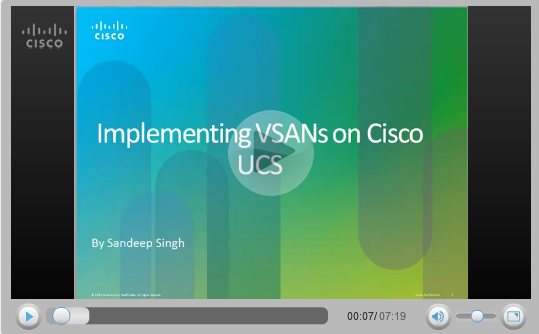Introduction
In UCS the implementation of VLAN and VSAN are influenced by the concepts of End-host mode and FCoE. The UCS system by default works in End-host mode. This mode of working is different than a regular switch mode. In End-host mode the UCS 6100 series fabric interconnect appears to the external LAN as an end station with many adapters. In UCS the Fibre Channel traffic is carried over Ethernet using FCoE protocol. Hence you will need to assign a separate VLAN that a VSAN will use inside the UCS environment.
VLAN implementation
In Unified Computing system (UCS) each VLAN is identified by a unique ID. The VLAN ID is a number that represents that particular VLAN. You can use a number of your choice to represent a VLAN however the range 3968 to 4048 is reserved and can not be used. While creating a VLAN in UCS, the VLAN is also assigned a name. The concept of naming a VLAN is used as it provides a layer of abstraction which is helpful in situations like where you need to update servers (using service profiles) that are in that VLAN. In case of a cluster configuration (two UCS 6100 series fabric interconnects in cluster) a named VLAN can be configured to be available from only one fabric interconnect or both of the fabric interconnects. This means that you can create a VLAN which is visible in either one fabric interconnect or both fabric interconnect. It is also possible to create separate VLANs with same name on both of the fabric interconnects but with different VLAN IDs. You can also create more than one named VLANs with the same VLAN ID. Note that the name of a VLAN is known only within the UCS environment, and outside of the UCS the VLAN is represented by the unique ID.
VSAN implementation
As in the case with VLAN, a VSAN can be created on either one of the fabric interconnects or both of the fabric interconnects. A VSAN is identified with a unique ID, which is a number, and is also assigned a name. While creating a VSAN it is mapped to a VLAN which it will use to carry the Fibre Channel traffic over Ethernet. As with the case of VLANs; VSANs can also be created with same name but different IDs on both of the fabric interconnects. After creating a VSAN it can then be assigned to a specific FC interface. The UCS 6100 series fabric interconnects run in N-Port virtualization (NPV) mode and all switching is performed by NPIV enabled northbound switch. Each fiber uplink from Cisco UCS to the distribution layer supports only one VSAN. This is specified as a property of the uplink. Note that UCS does not support F-Port trunking or port channels for FC and as such there is no HA designed into UCS for FC. However multipathing drivers and dual redundant fabric design can be utilized for HA.
Video
To learn more about VLANs on UCS check the following video.

To learn more about VSANs on UCS check the following video.

Related Information
Configuring VLANs on UCS and VMware
Procedure to Gracefully Shutdown and Powerup UCS system